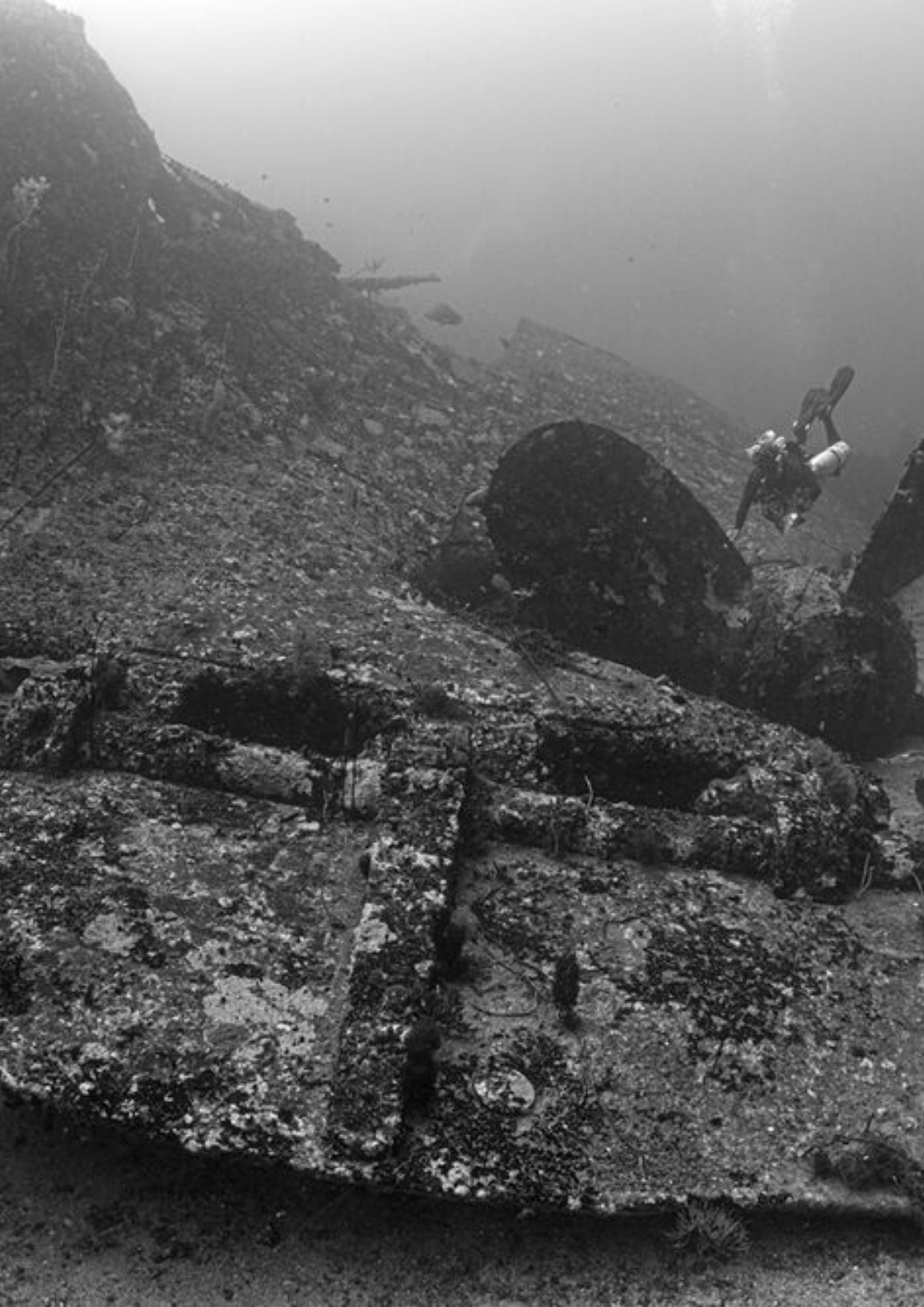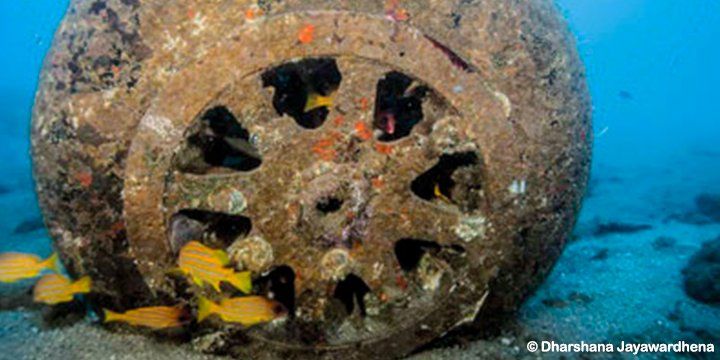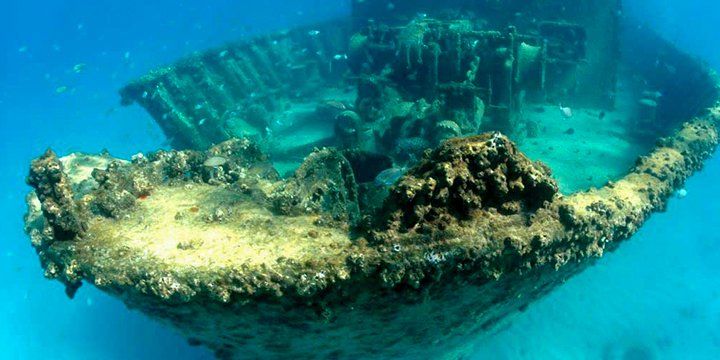
HMS HERMES

CONCH

CATALINA PBY-5A

TREASURE SHIP

MV TRICOLOR

SS RANGOON
SRI LANKA|PECIOS HISTÓRICOS
Destino de mochileros por excelencia, Sri Lanka es uno de los mejores destinos de inmersiones en pecios del Índico.
Passikudha. Hoy, asentado en el fondo del abismo, el Catalina PBY-5A del escuadrón holandés 321 Y-78, se estrelló frente a la costa el 9 de diciembre de 1943. El Catalina tenía la misión de destruir un submarino japonés que merodeaba cerca de las islas Andaman-Nicobar en la Bahía de Bengala. Afortunadamente, toda la tripulación de 11 miembros sobrevivió al accidente alcanzado la orilla 16 horas después. Este sitio, incluidos los motores y las hélices de la aeronave, fueron descubierto por primera vez por Dharshana Jayawardhena.
Kirinda. Frente a la profunda costa sur de la isla, Kirinda alberga los naufragios Little y Great Basses. La trágica historia detrás de este pecio del tesoro que perteneció al gran emperador mongol Aurangzed, es tan intrigante como el ecosistema que alberga. Descubierto por Sir Arthur C Clarke y su instructor de buceo en 1961, se cree que este barco fue una embarcación especial que transportaba una enorme cantidad de monedas de plata recién acuñadas y otros artefactos. El malogrado barco se hundió en 1703 mientras navegaba por la legendaria ruta de las especias. Debido a las fuertes corrientes, estos lugares solo se pueden visitar en marzo y abril.
Akkurala. Aquí yace uno de los famosos naufragios en el sur de Sri Lanka. Una vez guerrero, este pecio condenado, ahora es un colorido paraíso marino salpicado de peces, con varias especies al acecho. El petrolero británico Conch golpeó la roca Akkurala cerca de la costa de Hikkaduwa. La embarcación con un cargamento de varios miles de toneladas de petróleo a granel se partió en dos después de chocar contra el arrecife y apoyó contra la roca a una profundidad de 22 m. El Conch estaba en un viaje desde Novorossisk y Colombo hasta la costa de Madrás. Cientos de piezas de hierro del naufragio están esparcidas por todo el lecho marino y se puede ver claramente la máquina de vapor, las hélices, los ejes y las palancas que yacen en la tumba de agua.
Galle. A lo largo de la costa, en las áreas de Galle y Ambalangoda, ya se han encontrado más de 100 restos de pecios. Famoso por su extensa historia y triple dominación colonial, Galle es sin duda un tesoro a lo que naufragios se refiere. El Earl of Shaftesbury en Hikkaduwa y SS Rangoon en Unawatuna son algunos de los famosos barcos hundidos cuya propiedad ha sido reclamada por la naturaleza. Hoy, estos barcos son un oasis de vida marina.
Beruwala. El barco noruego MV Tricolor es el naufragio más profundo conocido (unos 65 m) encontrado en las aguas de Sri Lanka que se hundió frente a la costa de la isla en 1931. Hoy, el barco se encuentra a unos 15 km al oeste de Beruwala. Tricolor se hundió cuando navegaba al mediodía desde el puerto de Colombo con destino a Yokohama el 5 de enero de 1931. Según varias fuentes, el barco transportaba una carga de más de 825 toneladas, así como una cantidad significativa de productos químicos peligrosos, que se supone, causaron la explosión en el barco. Aunque el SS Porthos, un barco de vapor francés, pudo rescatar a 31 miembros de la tripulación y a sus diez pasajeros, cinco miembros de la tripulación, incluido el capitán, murieron en el desastre.
Batticaloa. El primer portaaviones del mundo, el HMS Hermes, que descendió al mundo etéreo bajo el agua durante la Segunda Guerra Mundial el 9 de abril de 1942. El casco abandonado se encuentra a una profundidad de poco más de 50 m frente a la costa este de la isla. El barco fue hundido por bombarderos japoneses y se hundió trágicamente después de 40 o más impactos directos de 70 bombarderos en picado. El número de muertos por el hundimiento del HMS Hermes superó los 300. el HMS Hermes fue un buque valiente en el frente de guerra, pero se convirtió en un prisionero del de las profundidades para la eternidad, hogar de peces, corales y otras criaturas marinas. La exploración en este cementerio de guerra, es como adentrarse en un museo submarino.
Además de los naufragios anteriores, el Colombo Cargo, Colombo Barge, el Colombo Tarprobane East y MV Cordiality en Poloddai son algunos de los naufragios famosos con historias interesantes de un tiempo pasado. Con todos estos tesoros submarinos, Sri Lanka es uno de los mejores destinos para los adictos a los pecios. ¡Sin duda un viaje que vale la pena!
Translate and adapted by Caco Pradas
SRI LANKA|HISTORIC WRECKS
Sri Lanka is one of the best destinations to discover the bizarrely beautiful wreck sites and their thrilling mysteries. So, we have put together a whole list of shipwrecks to spice up your wreck dive.
Passikudha.Today, settled at the bottom of the deep, the Dutch Squadron 321 Y-78 Catalina PBY-5A was crashed off the coast of Passikudha on December 9, 1943. The Catalina was on a mission to destroy a Japanese submarine prowling near the Andaman-Nicobar Islands in the Bay of Bengal. Fortunately, the entire crew of 11 members had survived the crash and reached the shore just 16 hours later. These Catalinas witnessed the sunrise twice during their journey, and thus aptly named the “Double Sunrise” flights. This site includes the engines and propellers of the aircraft.
Kirinda, off the deep south coast of the island, is home to the Little and Great Basses wrecks. The tragic story behind this treasure ship belonging to the great Moghul Emperor Aurangzeb is as intriguing as the ecosystem it hosts. Discovered by Sir Arthur C Clarke and his diving instructor in 1961, this ship is believed to be a special marine vessel that carried an enormous amount of newly minted silver coins and other artifacts. The ill-fated ship went down in 1703 while sailing the legendary spice route. Due to the rough currents, these spots can only be visited in March and April.
Akkurala. This is one of the famous wrecks in Southern Sri Lanka. Once a warrior, this doomed ship is now a colorful fish-studded marine paradise, with various species lurking around. The British tanker Conch struck the Akkurala rock close to the Hikkaduwa coast. The vessel with a cargo of several thousand tons of bulk oil broke in two after hitting the reef and rested against the rock at a depth of 22m. The Conch was on a voyage from Novorossisk and Colombo to the Madras coast. Hundreds of iron parts of the shipwreck are scattered all over the seabed and you can clearly spot the steam engine, propellers, proper shafts, and levers lying in the watery grave.
Galle. Along the coast in the Galle and Ambalangoda areas over 100 wrecks of ships are reported to have been found already. Famed for its extensive history and threefold colonial domination, Galle is undoubtedly a treasure trove of shipwrecks. Earl of Shaftesbury in Hikkaduwa and SS Rangoon in Unawatuna are some of the famous sunken vessels whose ownership has been claimed by nature. Today, these ships are an oasis of marine life.
Beruwala. The Norwegian ship, MV Tricolor is the deepest known shipwreck (about 65m) found in Sri Lanka’s waters that sank off the coast of the island in 1931. Today, the ship lies about 15km west of Beruwala. The tricolor was sunk in the water when she was sailing at noon from the Colombo Port bound for Yokohama on January 5, 1931. According to various sources, the ship had carried a general cargo of over 825 tons as well as a significant amount of dangerous chemicals, which were assumed to have caused the explosion on the ship. Though SS Porthos, a French steamer was able to rescue 31 crew members and all ten passengers, five crew members and including the Captain died in the maritime disaster.
Batticaloa. The world’s first aircraft carrier, HMS Hermes descended into the ethereal world underwater during World War II on April 9, 1942. The derelict hulk lies at a depth of a little over 50m off the East coast of the island. The ship was sunken by Japanese bombers and it went down tragically after 40 or more direct hits by 70 dive bombers. HMS Hermes sinking death toll exceeded 300. Once a brave lady at the war front, HMS Hermes is now a prisoner of the eerie undersea world, home to fish, corals, and other sea creatures. Exploring this marine vessel is akin to wading into an underwater museum.
Apart from the above wreck sites,
Colombo Cargo wreck,
Colombo Barge,
Colombo Tarprobane East wreck, and
MV Cordiality in Poloddai are some of the famous wrecks with interesting stories of a time gone by. With all these underwater treasures, Sri Lanka is one of the best destinations for adrenaline junkies that lure to the mysterious call of the world underwater and delve into the depths of the mighty Ocean.


